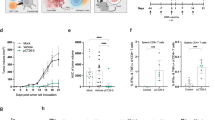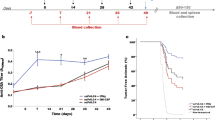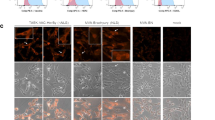Abstract
In vivo electroporation of plasmid DNA (DNA-EP) is an efficient and safe method for vaccines resulting in increased DNA uptake, enhanced protein expression and increased immune responses to the target antigen in a variety of species. To further enhance the efficacy of DNA-EP, we have evaluated the toll-like receptor7 (TLR7) agonist—2, 9, substituted 8-hydroxyadenosine derivative or SM360320—as an adjuvant to vaccines against HER2/neu and CEA in BALB-neuT and CEA transgenic mice (CEA.Tg), respectively. SM360320 induced in vivo secretion of interferon α (IFNα) and exerted a significant antitumor effect in CEA.Tg mice challenged with a syngenic tumor cell line expressing CEA and an additive effect with a CEA vaccine. Additionally, combination of SM360320 with plasmid encoding the extracellular and transmembrane domain of ratHER2/neu affected the spontaneous tumor progression in BALB-neuT mice treated in an advanced disease setting. The antitumor effect in mice treated with DNA-EP and SM360320 was associated with an anti-CEA and anti-p185neu antibody isotype switch from IgG1 to IgG2a. These data demonstrate that SM360320 exerts significant antitumor effects and can act in association with DNA-EP for CEA-positive colon cancer and HER2-positive mammary carcinoma. These observations therefore emphasize the potential of SM360320 as immunological adjuvant for therapeutic DNA vaccines.
This is a preview of subscription content, access via your institution
Access options
Subscribe to this journal
Receive 12 print issues and online access
$259.00 per year
only $21.58 per issue
Buy this article
- Purchase on Springer Link
- Instant access to full article PDF
Prices may be subject to local taxes which are calculated during checkout








Similar content being viewed by others
References
Hanke T . On DNA vaccines and prolonged expression of immunogens. Eur J Immunol 2006; 36: 806–809.
Lollini PL, Cavallo F, Nanni P, Forni G . Vaccines for tumour prevention. Nat Rev Cancer 2006; 6: 204–216.
Lollini PL, De Giovanni C, Pannellini T, Cavallo F, Forni G, Nanni P . Cancer immunoprevention. Future Oncol 2005; 1: 57–66.
Yu M, Finn OJ . DNA vaccines for cancer too. Cancer Immunol Immunother 2006; 55: 119–130.
Cappelletti M, Zampaglione I, Rizzuto G, Ciliberto G, La Monica N, Fattori E . Gene electro-transfer improves transduction by modifying the fate of intramuscular DNA. J Gene Med 2003; 5: 324–332.
Scheerlinck JP, Karlis J, Tjelle TE, Presidente PJ, Mathiesen I, Newton SE . In vivo electroporation improves immune responses to DNA vaccination in sheep. Vaccine 2004; 22: 1820–1825.
Zucchelli S, Capone S, Fattori E, Folgori A, Di Marco A, Casimiro D et al. Enhancing B- and T-cell immune response to a hepatitis C virus E2 DNA vaccine by intramuscular electrical gene transfer. J Virol 2000; 74: 11598–11607.
Widera G, Austin M, Rabussay D, Goldbeck C, Barnett SW, Chen M et al. Increased DNA vaccine delivery and immunogenicity by electroporation in vivo. J Immunol 2000; 164: 4635–4640.
Babiuk S, Baca-Estrada ME, Foldvari M, Storms M, Rabussay D, Widera G et al. Electroporation improves the efficacy of DNA vaccines in large animals. Vaccine 2002; 20: 3399–3408.
Aurisicchio L, Mennuni C, Giannetti P, Calvaruso F, Nuzzo M, Cipriani B et al. Immunogenicity and safety of a DNA prime/adenovirus boost vaccine against rhesus CEA in nonhuman primates. Int J Cancer 2007; 120: 2290–2300.
Hodge JW, Greiner JW, Tsang KY, Sabzevari H, Kudo-Saito C, Grosenbach DW et al. Costimulatory molecules as adjuvants for immunotherapy. Front Biosci 2006; 11: 788–803.
Overwijk WW, de Visser KE, Tirion FH, de Jong LA, Pols TW, van der Velden YU et al. Immunological and antitumor effects of IL-23 as a cancer vaccine adjuvant. J Immunol 2006; 176: 5213–5222.
Taieb J, Chaput N, Schartz N, Roux S, Novault S, Ménard C et al. Chemoimmunotherapy of tumors: cyclophosphamide synergizes with exosome based vaccines. J Immunol 2006; 176: 2722–2729.
Comes A, Rosso O, Orengo AM, Di Carlo E, Sorrentino C, Meazza R et al. CD25+ regulatory T cell depletion augments immunotherapy of micrometastases by an IL-21-secreting cellular vaccine. J Immunol 2006; 176: 1750–1758.
Ahonen CL, Doxsee CL, McGurran SM, Riter TR, Wade WF, Barth RJ et al. Combined TLR and CD40 triggering induces potent CD8+ T cell expansion with variable dependence on type I IFN. J Exp Med 2004; 199: 775–784.
Smorlesi A, Papalini F, Orlando F, Donnini A, Re F, Provinciali M . Imiquimod and S-27609 as adjuvants of DNA vaccination in a transgenic murine model of HER2/neu-positive mammary carcinoma. Gene Therapy 2005; 12: 1324–1332.
Kaisho T, Akira S . Toll-like receptor function and signaling. J Allergy Clin Immunol 2006; 117: 979–987; quiz 988.
Weeratna RD, Makinen SR, McCluskie MJ, Davis HL . TLR agonists as vaccine adjuvants: comparison of CpG ODN and resiquimod (R-848). Vaccine 2005; 23: 5263–5270.
Takeuchi O, Sato S, Horiuchi T, Hoshino K, Takeda K, Dong Z et al. Cutting edge: role of Toll-like receptor 1 in mediating immune response to microbial lipoproteins. J Immunol 2002; 169: 10–14.
Yang Y, Zhou H, Yang Y, Li W, Zhou M, Zeng Z et al. Lipopolysaccharide (LPS) regulates TLR4 signal transduction in nasopharynx epithelial cell line 5-8F via NFkappaB and MAPKs signaling pathways. Mol Immunol 2006; 44: 984–992.
Tsan MF . Toll-like receptors, inflammation and cancer. Semin Cancer Biol 2006; 16: 32–37.
Kurimoto A, Ogino T, Ichii S, Isobe Y, Tobe M, Ogita H et al. Synthesis and evaluation of 2-substituted 8-hydroxyadenines as potent interferon inducers with improved oral bioavailabilities. Bioorg Med Chem 2004; 12: 1091–1099.
Clarke P, Mann J, Simpson JF, Rickard-Dickson K, Primus FJ . Mice transgenic for human carcinoembryonic antigen as a model for immunotherapy. Cancer Res 1998; 58: 1469–1477.
Lucchini F, Sacco MG, Hu N, Villa A, Brown J, Cesano L et al. Early and multifocal tumors in breast, salivary, harderian and epididymal tissues developed in MMTY-Neu transgenic mice. Cancer Lett 1992; 64: 203–209.
Thompson JA, Grunert F, Zimmermann W . Carcinoembryonic antigen gene family: molecular biology and clinical perspectives. J Clin Lab Anal 1991; 5: 344–366.
Slamon DJ, Clark GM, Wong SG, Levin WJ, Ullrich A, McGuire WL . Human breast cancer: correlation of relapse and survival with amplification of the HER-2/neu oncogene. Science 1987; 235: 177–182.
Slamon DJ, Godolphin W, Jones LA, Holt JA, Wong SG, Keith DE et al. Studies of the HER-2/neu proto-oncogene in human breast and ovarian cancer. Science 1989; 244: 707–712.
Facciabene A, Aurisicchio L, Elia L, Palombo F, Mennuni C, Ciliberto G et al. DNA and adenoviral vectors encoding carcinoembryonic antigen fused to immunoenhancing sequences augment antigen-specific immune response and confer tumor protection. Hum Gene Ther 2006; 17: 81–92.
Facciabene A, Aurisicchio L, Elia L, Palombo F, Mennuni C, Ciliberto G et al. Vectors encoding carcinoembryonic antigen fused to the B subunit of heat-labile enterotoxin elicit antigen-specific immune responses and antitumor effects. Vaccine 2007; 26: 47–58.
Elia L, Aurisicchio L, Facciabene A, Giannetti P, Ciliberto G, La Monica N et al. CD4+CD25+ regulatory T-cell-inactivation in combination with adenovirus vaccines enhances T-cell responses and protects mice from tumor challenge. Cancer Gene Ther 2007; 14: 201–210.
Boggio K, Nicoletti G, Di Carlo E, Cavallo F, Landuzzi L, Melani C et al. Interleukin 12-mediated prevention of spontaneous mammary adenocarcinomas in two lines of Her-2/neu transgenic mice. J Exp Med 1998; 188: 589–596.
Quaglino E, Mastini C, Iezzi M, Forni G, Musiani P, Klapper LN et al. The adjuvant activity of BAT antibody enables DNA vaccination to inhibit the progression of established autochthonous Her-2/neu carcinomas in BALB/c mice. Vaccine 2005; 23: 3280–3287.
De Giovanni C, Nicoletti G, Landuzzi L, Astolfi A, Croci S, Comes A et al. Immunoprevention of HER-2/neu transgenic mammary carcinoma through an interleukin 12-engineered allogeneic cell vaccine. Cancer Res 2004; 64: 4001–4009.
Nanni P, Nicoletti G, De Giovanni C, Landuzzi L, Di Carlo E, Iezzi M et al. Prevention of HER-2/neu transgenic mammary carcinoma by tamoxifen plus interleukin 12. Int J Cancer 2003; 105: 384–389.
Gallo P, Dharmapuri S, Nuzzo M, Maldini D, Iezzi M, Cavallo F et al. Xenogeneic immunization in mice using HER2 DNA delivered by an adenoviral vector. Int J Cancer 2005; 113: 67–77.
Rizzuto G, Cappelletti M, Maione D, Savino R, Lazzaro D, Costa P et al. Efficient and regulated erythropoietin production by naked DNA injection and muscle electroporation. Proc Natl Acad Sci U S A 1999; 96: 6417–6422.
Giannetti P, Facciabene A, La Monica N, Aurisicchio L . Individual mouse analysis of the cellular immune response to tumor antigens in peripheral blood by intracellular staining for cytokines. J Immunol Methods 2006; 316: 84–96.
Mennuni C, Calvaruso F, Facciabene A, Aurisicchio L, Storto M, Scarselli E et al. Efficient induction of T-cell responses to carcinoembryonic antigen by a heterologous prime-boost regimen using DNA and adenovirus vectors carrying a codon usage optimized cDNA. Int J Cancer 2005; 117: 444–455.
Beutner KR, Tyring SK, Trofatter Jr KF, Douglas Jr JM, Spruance S, Owens ML et al. Imiquimod, a patient-applied immune-response modifier for treatment of external genital warts. Antimicrob Agents Chemother 1998; 42: 789–794.
Manetti R, Annunziato F, Tomasevic L, Giannò V, Parronchi P, Romagnani S et al. Polyinosinic acid: polycytidylic acid promotes T helper type 1-specific immune responses by stimulating macrophage production of interferon-alpha and interleukin-12. Eur J Immunol 1995; 25: 2656–2660.
Wills RJ . Clinical pharmacokinetics of interferons. Clin Pharmacokinet 1990; 19: 390–399.
Sundstedt A, Celander M, Hedlund G . Combining tumor-targeted superantigens with interferon-alpha results in synergistic anti-tumor effects. Int Immunopharmacol 2008; 8: 442–452.
Salucci V, Lena AM, Ciliberto G, Scarselli E, La Monica N . Adenovirus transduction and culture conditions affect the immunogenicity of murine dendritic cells. Scand J Immunol 2005; 62: 206–217.
Cipriani B, Fridman A, Bendtsen C, Dharmapuri S, Mennuni C, Pak I et al. Therapeutic vaccination halts disease progression in BALB-neuT mice: the amplitude of elicited immune response is predictive of vaccine efficacy. Hum Gene Ther 2008; 19: 670–680.
Coppin C . Immunotherapy for renal cell cancer in the era of targeted therapy. Expert Rev Anticancer Ther 2008; 8: 907–919.
Thomsen LL, Topley P, Daly MG, Brett SJ, Tite JP . Imiquimod and resiquimod in a mouse model: adjuvants for DNA vaccination by particle-mediated immunotherapeutic delivery. Vaccine 2004; 22: 1799–1809.
Mori F, Giannetti P, Peruzzi D, Lazzaro D, Giampaoli S, Kaufman HL et al. A therapeutic cancer vaccine targeting carcinoembryonic antigen in intestinal carcinomas. Hum Gene Ther 2008 (in press).
Nanni P, Landuzzi L, Nicoletti G, De Giovanni C, Rossi I, Croci S et al. Immunoprevention of mammary carcinoma in HER-2/neu transgenic mice is IFN-gamma and B cell dependent. J Immunol 2004; 173: 2288–2296.
Renard V, Sonderbye L, Ebbehoj K, Rasmussen PB, Gregorius K, Gottschalk T et al. HER-2 DNA and protein vaccines containing potent Th cell epitopes induce distinct protective and therapeutic antitumor responses in HER-2 transgenic mice. J Immunol 2003; 171: 1588–1595.
Park JM, Terabe M, Sakai Y, Munasinghe J, Forni G, Morris JC et al. Early role of CD4+ Th1 cells and antibodies in HER-2 adenovirus vaccine protection against autochthonous mammary carcinomas. J Immunol 2005; 174: 4228–4236.
Indar A, Maxwell-Armstrong CA, Durrant LG, Carmichael J, Scholefield JH . Current concepts in immunotherapy for the treatment of colorectal cancer. J R Coll Surg Edinb 2002; 47: 458–474.
Mastini C, Becker PD, Iezzi M, Curcio C, Musiani P, Forni G et al. Intramammary application of non-methylated-CpG oligodeoxynucleotides (CpG) inhibits both local and systemic mammary carcinogenesis in female BALB/c Her-2/neu transgenic mice. Curr Cancer Drug Targets 2008; 8: 230–242.
Acknowledgements
This study was funded by Ministero dell’Istruzione, dell’Università e della Ricerca; Grant number FIRB RBME017BC4. We acknowledge Dr Guido Forni for BALB-neuT mice, Drs C Bentsen, I Pak, A Fridman and A Bagchi for statistical analysis, M Emili for graphics and J Clench for editorial assistance.
Author information
Authors and Affiliations
Corresponding author
Rights and permissions
About this article
Cite this article
Dharmapuri, S., Aurisicchio, L., Neuner, P. et al. An oral TLR7 agonist is a potent adjuvant of DNA vaccination in transgenic mouse tumor models. Cancer Gene Ther 16, 462–472 (2009). https://doi.org/10.1038/cgt.2008.91
Received:
Accepted:
Published:
Issue Date:
DOI: https://doi.org/10.1038/cgt.2008.91



